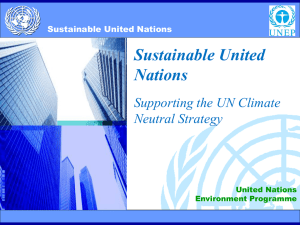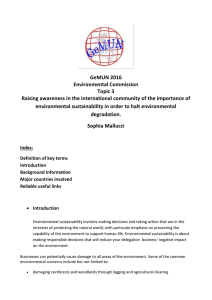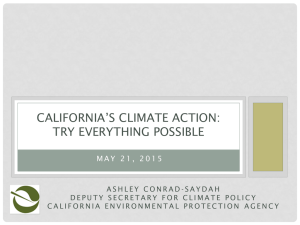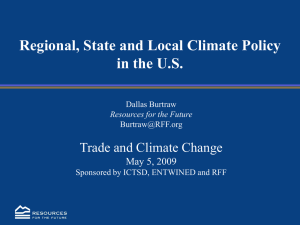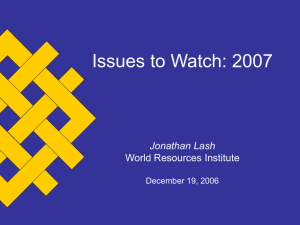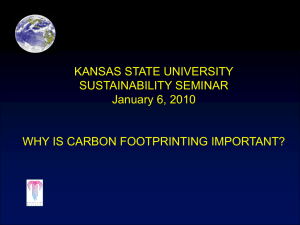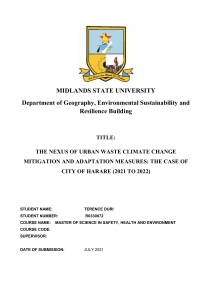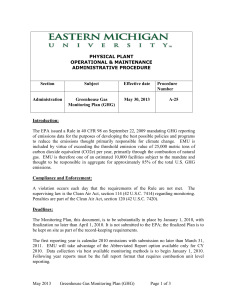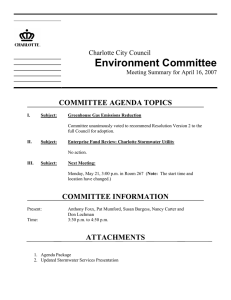Sustainable United Nations Supporting the UN Climate Neutral Strategy
advertisement
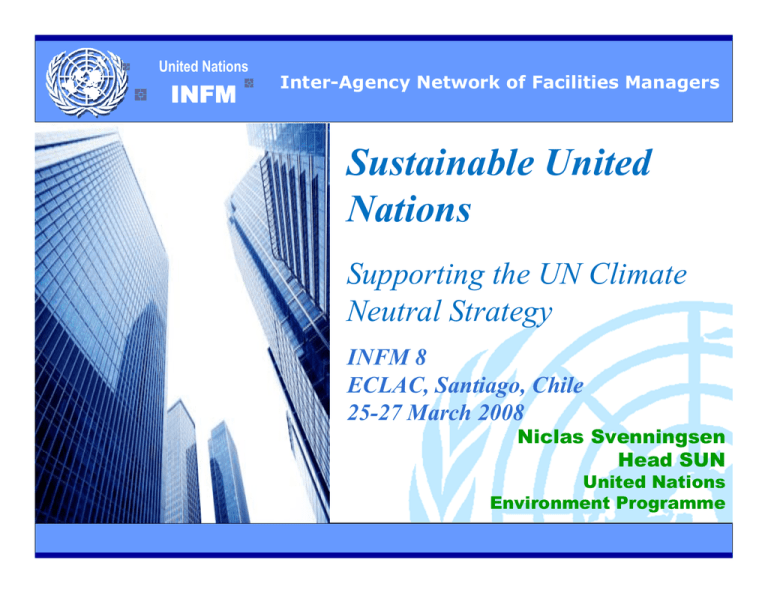
United Nations INFM Inter-Agency Network of Facilities Managers Sustainable United Nations Supporting the UN Climate Neutral Strategy INFM 8 ECLAC, Santiago, Chile 25-27 March 2008 Niclas Svenningsen Head SUN United Nations Environment Programme 1 SUN • • The Big Picture • • • • Our Current Impact The UN Climate Neutral Strategy Areas of Opportunity Sustainable UN Six Steps Towards Climate Neutrality Here Comes the SUN SUN Climate Change in a Nutshell GHG emissions increased by 70% from 1970 to 2004 GHG levels in the atmosphere are the highest in 650.000 years The question is not IF? but HOW MUCH? Mitigation costs are estimated to 1% of global GDP per year Costs of no action is estimated to 20% of global GDP per year Climate Change is THE global threat! Where is UN? SUN Ban Ki-Moon UN SG • • • More than setting a good example UN SG pledged, on World Environment Day (5 June 2007) “…to explore ways of making the United Nations more climate friendly and environmentally sustainable, and to develop a climate-neutral approach to its premises and operations.” Climate Change impacts almost all mandates of UN. More and more UN organizations are challenged by their governing bodies and member states Our ability depends much on our credibility SUN Strategy for Climate Neutral UN Statement of the Chief Executives Board (26 October 2007) : “We, the Heads of the United Nations agencies, funds and programmes, hereby commit ourselves to moving our respective organizations towards climate neutrality in our headquarters and United Nations centres for our facility operations and travel.” In particular, by the end of 2009 we will: • Estimate our greenhouse gas emissions consistent with accepted international standards; • Undertake efforts to reduce our greenhouse gas emissions to the extent possible; and • Analyze the cost implications and explore budgetary modalitiesincluding consulting with governing bodies as needed - of purchasing carbon offsets to eventually reach climate neutrality. SUN Definitions and Boundaries “Climate neutrality” is defined by the entire set of polices that an institution uses when it estimates its known greenhouse gas emissions, takes measures to reduce them, and purchases carbon offsets to “neutralize” those emissions that remain. Greenhouse gases are defined as the six gases covered by the Kyoto Protocol: CO2, CH4, N20, HFCs, PFCs, SF6 Included are facilities (HQ and field offices) and activities within these, official vehicles, official travel of staff and meeting participants financed by the organization. Not included are: activities not directly controlled by management, such as the personal sphere of staff or projects implemented in partnership with other organizations SUN Our Current Impact? Extrapolating provided data indicates a total emission from UN in the range of 1 million tons of CO2eq (Source EMG 2007) SUN A Few Examples of Initiatives ADB ¾ Replace incandescent bulbs with CFL ¾ Installation of solar panels ¾ 89% recycling of construction materials ¾ 7% reduction of paper use (office) ¾ 100% segregation and 80% recovery of solid waste UNBonn ¾ 100% Green electricity in all UN facilities ¾ Building automation systems to control HVAC ¾ Lights and water tap timers/sensors, double flush toilets CTBTO ¾ Double sided printing by default ¾ Pursue digital information storage ¾ Move from personal printers to common copying, printing and scanning islands. OPCW ¾ Good efficiency in use of office space ¾ Air-to-air heat recovery ¾ Computer operated external shading system ¾ Use of personal motor vehicles discouraged ¾ Regular comparison of performance against benchmarks SUN Sustainable United Nations A UNEP Initiative to assist UN organizations and other public organizations to achieve Climate Neutrality and improved sustainability The focus of SUN: Direct and indirect sources of emissions and other forms of impact from buildings, operations, travel, management systems and staff culture SUN will: Assist in identification, quantification and justification of opportunities for emission reduction. Provide tools, methodologies and guidelines. Support information exchange and access to outside expertise Priority Areas SUN 9 9 9 9 9 9 9 Building design Energy systems (power supply, heat/cool, HVAC, lighting, etc) Water and waste systems Chemicals use Procurement (travel, transport, equipment etc). Management policies In-office culture Office equipm ent Occupant behavioiur Engineering HVAC Energy systems & Materials w aste Building design & Water w aste w ater Lighting Working with SUN SUN 1. Working with SUN is voluntary 2. The UN Climate Neutral goal is already adopted 3. SUN will help you to do the work – not do the work for you. 4. Working with climate neutrality will still require time and resources from your organization 5. SUN is not an audit and not a certification! 6. It is still early dawn but we expect a sunny day! SUN Responsibilities and benefits What you commit to by working with SUN 1. Assign contact person 2. Provide data and access for initial assessment 3. To jointly (with SUN) elaborate a GHG reduction action plan 4. Provide regular reports on implementation of action plan What SUN commits to you 1. Assist in initial assessment through site visit, expert advice and analysis of data. 2. Help you to develop the action plan 3. To verify and justify requests for funding. 4. To assist in implementation of action plan as is feasible. 5. To provide tools and methodologies, links to experts and service and technology providers. 6. Prepare and make available a web-based know-how sharing facility where resources, case studies and other resources are pooled. SUN How to start working together 1. Sign LoA & assign contact person 2. Conduct Initial assessment: a) Data collection b) Site visit c) GHG inventory 3. In-depth analysis of selected areas 4. Develop action plan and present to governing body for approval/funding 5. Implementation of plan and reporting to SUN 6. a) Buildings b) Operations c) Culture Prepare for GHG offset purchasing by december 2009 SUN Put on your SUN hats! SUN will only be as successful as you are in meeting the climate change challenge. This is our common agenda. Let us know your ideas for how SUN can help you! Questions for discussion: 1. Is GHG emission reduction or sustainability a priority for your work? 2. What do you need to be able to effectively address these issues? 3. What kind of assistance from SUN would be helpful? 4. Are there any specific issues you would need help with? SUN THANK YOU Sustainable.un@unep.fr www.unep.fr
